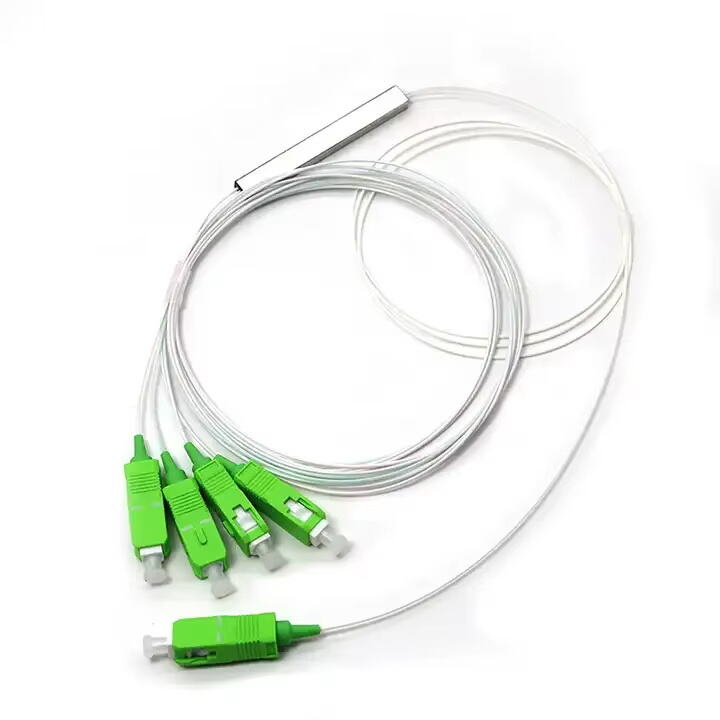현대 통신에서의 PLC 스플리터 이해하기
정의 및 핵심 기능
PLC 분배기는 오늘날의 통신 시스템에서 중요한 구성 요소로 작용합니다. 기본적으로 이들은 평면 광회로(Planar Lightwave Circuit)를 이용하여 하나의 광학 신호를 여러 개의 출력 신호로 나누어 네트워크 전반에 걸쳐 신호를 효율적으로 분배하는 역할을 합니다. 특히 광섬유 설비에서 PLC 분배기는 신호 품질을 유지하면서 여러 개의 끝단(Endpoint)을 단일 소스에서 연결할 수 있게 해주므로 그 중요성이 더욱 커집니다. 이러한 분배기들은 긴 거리를 통해 데이터를 전송하더라도 신호 강도를 일정하게 유지함으로써 네트워크 성능을 향상시킵니다. PLC 분배기의 독특한 점은 다양한 분할 비율(Splitting Ratio)을 처리할 수 있는 능력에 있습니다. 따라서 다양한 유형의 네트워크 환경에 유연하게 적용될 수 있습니다. 운영자는 인프라 요구 사항에 따라 분할 비율을 조정할 수 있는데, 이는 다수의 연결이 필요한 지역이나 상대적으로 수요가 적은 지역 모두에서 유연하게 적용이 가능하다는 의미입니다. 이러한 유연성 덕분에 네트워크는 전체적인 개편 없이도 확장 및 변화에 대응할 수 있습니다.
신호 분배 워크플로우
PLC 분배기가 신호 분배와 함께 작동하는 방식을 이해하려면 광신호가 분배기에 들어가서 분할된 후 여러 개의 출력을 통해 나가는 과정을 살펴봐야 합니다. 여기서 중요한 점은 신호가 모든 출력에 균일하게 분배되어 주거용 고객이나 기업용 장소로 전달되든 상관없이 통신 서비스의 품질을 유지하는 것입니다. 분배 과정에서 문제가 발생하면 신호 손실이 생겨 서비스 품질이 저하되기 때문에 이 과정을 정확하게 수행하는 것이 매우 중요합니다. 균형 잡힌 분배를 유지하면 하루 종일 안정적인 연결에 의존하는 대규모 네트워크 전반에서 신호가 강력하게 유지될 수 있습니다. 올바르게 설정된 PLC 분배기는 신호가 성능 저하 없이 목적지까지 신뢰성 있게 전달될 수 있는 경로를 생성합니다.
플래너 라이트웨이브 서킷 기술
요즘 광회로 설계 방식에 있어 플래너 라이트웨이브 서킷(PLC) 기술은 거의 게임 체인저가 되었습니다. 기본적으로 이 기술은 회로를 얇은 유리 기판 위에 바로 제작함으로써 빛이 표면 상의 특정 경로를 매우 정확하게 따라가도록 합니다. 장비 공간이 점점 줄어드는 통신 업체들에게 PLC의 소형 설계는 필수적입니다. 이 시스템들은 작은 공간에 매우 다양한 기능을 집적하고 있기 때문에 물리적 공간 절약이 특히 중요한 여러 응용 분야에서 표준으로 자리 잡아가고 있습니다. 또 다른 큰 장점은 PLC 기술이 작동 중 내내 매우 일관된 광신호를 제공하여 신호 손실을 줄이고 장기적인 성능 안정성을 유지해 준다는 점입니다. 네트워크 운용자들은 이 기술이 확실히 더 나은 성능을 보여주기 때문에 인프라 전반에 걸쳐 이 기술을 도입하고 있습니다. 데이터 트래픽이 빠르게 증가함에 따라 신뢰성 있고 효율적인 광학 부품을 갖추는 것이 서비스 품질을 유지하면서도 전체 시스템을 끊임없이 업그레이드하지 않아도 되는 관건이 되고 있습니다.
분할 비율 역학
PLC 스플리터의 분할 비율은 기본적으로 들어오는 신호가 여러 출력 포트 사이에서 어떻게 분할되는지를 알려줍니다. 대부분 1 대 2, 1 대 4 또는 1 대 8과 같은 비율을 흔히 볼 수 있는데, 이는 광신호가 그만큼의 별도 경로로 나뉘는 것을 의미합니다. 네트워크를 설계하는 사람들에게는 이것이 매우 중요합니다. 왜냐하면 연결해야 할 장비의 수에 따라 적절한 스플리터를 선택하면서도 신호가 충분히 강하게 유지되어 제대로 작동할 수 있어야 하기 때문입니다. 엔지니어들이 이러한 비율 숫자들을 꼼꼼히 살펴보면 자신의 시스템 구성으로부터 기대할 수 있는 성능에 대해 보다 명확한 그림을 가질 수 있습니다. 이는 네트워크 배치도를 계획할 때 어디에 무엇을 설치할지 결정하는 데 도움이 됩니다. 철저한 계획은 전체 시스템이 품질 저하 없이 원활하게 작동하고 향후 문제가 발생하지 않도록 보장해 줍니다.
저손실 삽입 성능
PLC 분기기는 삽입 손실이 매우 낮아 운용 측면에서 큰 이점을 제공하며, 일반적으로 약 0.5dB 이하를 유지합니다. 신호 손실이 거의 발생하지 않는다는 사실은 시스템 전반에서 우수한 신호 품질을 유지하는 데 결정적인 차이를 만듭니다. 이러한 방식으로 데이터는 더욱 원활하게 흐르며 전송의 신뢰성도 유지됩니다. 통신 네트워크를 운용하는 사람이라면 누구나 디시벨 단위로 측정되는 작은 손실조차도 전체 시스템의 작동 성능에 상당한 영향을 미칠 수 있다는 점을 잘 알고 있으며, 때로는 서비스 품질의 눈에 띄는 저하를 초래하기도 합니다. 이러한 분기기가 삽입 손실을 효과적으로 관리함으로써 네트워크 운용자는 데이터 무결성을 걱정하지 않고 인프라를 훨씬 더 멀리 확장할 수 있습니다. 실제적으로 이는 더 넓은 지역에서 일관된 연결을 가능하게 하며, 궁극적으로 대규모 광케이블 구축 프로젝트가 실제 현장에서 보다 효과적으로 작동할 수 있도록 해줍니다.
네트워크 확장 시 확장성
PLC 분기기는 네트워크 확장에 있어서 실제적인 이점을 제공하며, 기존 인프라를 손상시키지 않고도 새로운 연결을 추가할 수 있게 해줍니다. 특히 요즘 통신 분야에서는 모든 사람이 이전보다 더 빠른 인터넷 속도와 더 많은 대역폭을 요구하고 있기 때문에 이는 매우 중요합니다. 최근 가정용 광대역 사용량이 급증했으며, 원격 근무 환경을 위한 안정적인 연결성을 필요로 하는 기업들도 많아지고 있습니다. PLC 기술은 트래픽 증가에 따라 네트워크가 자연스럽게 성장할 수 있도록 도와주며, 갑작스러운 대규모 개조를 피할 수 있습니다. 경쟁에서 살아남기 위해 통신사업자들은 매끄럽게 확장하면서도 증가하는 데이터 수요를 충족시킬 수 있어야 하며, 이는 더 이상 선택사항이 아닌 필수사항이 되고 있습니다. 이러한 이유로 많은 기업들이 확장에 PLC 솔루션을 도입하고 있는 것입니다.
수동 광망 (pon)
PLC 분배기는 수동 광 네트워크(PON)에서 매우 중요한 구성 요소입니다. 이들은 하나의 광섬유를 통해 들어오는 신호를 분할하여 여러 고객이 각각의 연결을 가질 수 있도록 해주며, 중간에 추가적인 전원 장비가 필요하지 않습니다. 이러한 방식의 장점은 네트워크 효율을 높이는 동시에 비용을 절감할 수 있다는 것입니다. 활성 장비와 같은 고가의 장비들이 불필요하기 때문입니다. 이처럼 뛰어난 성능 덕분에 PLC 분배기는 인터넷 및 전화 서비스를 보다 많은 사람들에게 제공할 수 있게 도와주며, 그렇지 않으면 서비스를 받지 못하는 지역도 혜택을 볼 수 있습니다. PON 시스템을 구축할 때 PLC 분배기를 사용함으로써 전체 설계에 큰 영향을 미치게 됩니다. 통신사들은 기존보다 훨씬 적은 인프라 투자로 많은 가입자를 연결할 수 있게 되었으며, 이는 고객에게 더 나은 접근성을 제공하고, 새로운 지역이 향후 네트워크에 추가될 때도 용이한 확장성을 보장합니다.

집까지 광섬유 연결하기 집 (FTTH) 시스템
PLC 분기기는 Fiber-to-the-Home(FTTH) 시스템에서 고속 광섬유 신호를 개별 가정과 아파트로 분배하는 핵심적인 역할을 합니다. 이는 초고속 다운로드 속도를 구현하고 연결을 안정적으로 유지하는 데 매우 중요합니다. 누군가가 4K 영화를 스트리밍하려 할 때 다른 가족 구성원이 온라인 게임을 하고 있는 상황을 생각해보세요. 제대로 된 분기 기술이 없다면 버퍼링으로 인해 악몽과 같은 경험을 하게 됩니다. 이제 가정에서는 기가비트 속도를 표준으로 요구하고 있기 때문에, 네트워크 사업자들은 적절한 PLC 분기기의 설치가 얼마나 중요한지 간과할 수 없습니다. 업계 보고서에 따르면 전 세계적으로 FTTH 설치가 연간 15% 이상 성장하고 있으며, 이는 이 인프라가 얼마나 필수적인지를 보여줍니다. 경쟁 우위를 유지하려는 통신 회사들이라면 고품질 PLC 분기기 솔루션에 투자하는 것이 현재의 요구사항을 충족하는 것을 넘어, 향후 집안 연결성 기술의 발전에 대비하는 일이라는 점을 이해해야 합니다.
데이터 센터 상호 연결
PLC 분배기는 이제 대부분의 데이터 센터 구성에 필수적인 장비가 되었으며, 다수의 연결을 처리하고 복잡한 네트워크를 통해 트래픽을 라우팅하는 데 효과적인 방법을 제공합니다. 작고 컴팩트한 크기와 신뢰성 있는 성능으로 인해 이러한 장비는 다양한 장비들이 밀집된 공간에서도 효율적으로 작동할 수 있습니다. 데이터 센터는 끊임없이 대량의 정보를 처리하면서도 신속하게 데이터 흐름을 유지해야 하기 때문에 이러한 효율성이 특히 중요합니다. 업계 자료에 따르면 기업이 PLC 분배기를 설치할 경우 인프라 구축 비용을 절감하고 시스템 전반에 걸쳐 데이터 흐름을 더욱 원활하게 만듦으로써 운영 효율성이 크게 향상되는 경우가 많습니다. 최신 데이터 센터를 운영하는 사람들에게는 이러한 소형 부품들이 통신 흐름을 매끄럽게 유지하고 소중한 데이터가 목적지에 무사히 도달할 수 있도록 보장하는 데 중요한 역할을 합니다.
기업 네트워크 구축
PLC 분배기는 기업 네트워크에서 필수적인 구성 요소로, 건물 전체에 신호를 분배하여 부서와 팀이 내부적으로 통신할 수 있도록 지원합니다. 모든 곳에 별도의 케이블을 연결하는 대신, 하나의 분배기로 여러 연결을 동시에 처리할 수 있어 배선을 간소화합니다. 또한, 이러한 장치는 문제가 발생할 수 있는 지점이 줄어들어 네트워크 안정성을 향상시켜 문제 발생 시 다운타임을 최소화합니다. 업계 데이터에 따르면 PLC 분배기를 설치한 기업은 일반적으로 더욱 원활한 신호 관리와 원활한 일상 운영을 경험하며, 특히 통신 요구가 증가함에 따라 더욱 그렇습니다. 사업 확장을 담당하는 IT 관리자에게 PLC 분배기는 복잡한 네트워크 설정 관리에 따른 어려움을 줄이는 동시에 사용량이 많은 시간대에도 모든 것이 원활하게 운영될 수 있도록 지원합니다.
설치 매개변수
PLC 스플리터를 올바르게 설치하는 것은 네트워크 성능이 얼마나 잘 작동하는지에 큰 차이를 만듭니다. 전체 과정은 설치 중에 실제로 중요한 사항들을 아는 것에서부터 시작됩니다. 파장 사양(wavelength specs)이 매우 중요하며, 스플리터가 환경 내에서 정확히 어떤 위치에 설치되는지, 그리고 모든 구성 요소가 네트워크 전체 구조에 어떻게 적합하는지도 중요합니다. 제조사의 설치 가이드라인을 따르는 것은 단지 좋은 관행이 아니라, 스플리터가 오랜 기간 동안 더 잘 작동하도록 실제로 도와줍니다. 설치 담당자가 초기 단계에서 이러한 세부 사항을 신경 써서 처리하면, 신호 손실(signal loss)과 같은 원치 않는 문제로 인한 골치거리를 나중에 피할 수 있습니다. 신호가 개선되면 연결이 끊어지거나 품질이 낮은 전송으로 인해 불편을 겪지 않는 만족한 사용자가 생기게 됩니다. 올바른 설치는 소규모 로컬 네트워크든 여러 장소에 걸쳐 있는 대규모 기업 시스템이든, 어떤 경우에도 효과를 발휘합니다.
정비 프로토콜
신호 손실과 같은 문제를 피하고 PLC 스플리터가 수명 주기 동안 잘 작동하도록 하려면 정기적인 유지보수 루틴이 매우 중요합니다. 무엇을 해야 할까요? 일정한 간격으로 광 신호를 점검하고, 손상이나 마모의 징후가 있는지 시각적으로 주변을 확인하며, 시스템의 부품이 필요할 때마다 업그레이드하십시오. 기업이 이러한 유지보수 일정을 철저히 지키게 되면 네트워크 다운타임이 상당히 감소합니다. 적절한 유지보수 후 효율성이 향상된 사례를 우리는 이미 확인했습니다. 이는 고장이 나기 전에 미리 조치를 취하면 신호가 지속적으로 안정되고 시스템이 날마다 신뢰성 있게 작동하기 때문입니다.
자주 묻는 질문 섹션
PLC 스플리터는 무엇에 사용되나요?
PLC 스플리터는 광섬유 네트워크에서 단일 광 입력 신호를 여러 출력 신호로 분할하여 신호 품질의 큰 저하 없이 효율적인 분배가 가능하도록 합니다.
PLC 분할기는 어떻게 작동할까요?
PLC 분배기는 평면 광회로를 사용하여 입력된 광신호를 여러 출력 단자에 고르게 분배하여 다양한 엔드포인트에 일관된 신호 전달을 보장합니다.
PLC 분배기에서 흔히 사용되는 분할 비율은 무엇입니까?
일반적인 분할 비율에는 1:2, 1:4, 1:8이 있으며, 이는 입력 신호가 출력 경로들 간에 어떻게 분배되는지를 결정합니다.
PLC 분배기에서 삽입 손실이 낮은 것이 중요한 이유는 무엇입니까?
낮은 삽입 손실은 신호 품질이 높은 상태를 유지하게 하여 긴 거리에 걸친 효율적이고 신뢰성 있는 데이터 전송이 가능하도록 하며 신호의 현저한 감쇠를 방지합니다.
PLC 분배기가 수동 광 네트워크(PON)에서 수행하는 역할은 무엇입니까?
PON에서 PLC 분배기는 하나의 광섬유에서 여러 가입자에게 신호를 효율적으로 분배하며, 전원이 공급되는 장비 없이도 작동하므로 네트워크 효율성과 비용 효율성을 최적화합니다.

